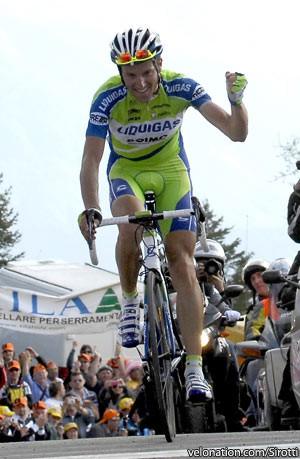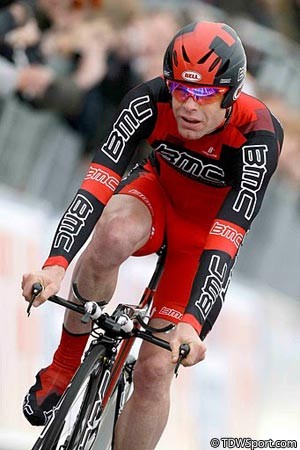Insight on key Giro d’Italia stage by Bbox Bouygues Telecom’s coach
 The Giro d’Italia organizers have decided to put two of the toughest climbs in cycling in back-to-back stages this year. On Sunday Ivan Basso won at the top of Monte Zoncalon, with the Plan de Corones uphill time trial the next daunting challenge for the peloton.
The Giro d’Italia organizers have decided to put two of the toughest climbs in cycling in back-to-back stages this year. On Sunday Ivan Basso won at the top of Monte Zoncalon, with the Plan de Corones uphill time trial the next daunting challenge for the peloton.
The time trial follows the road as it rises from San Vigilio to the top of the 1738 meter Passo Furcia, then changing from the asphalt road to a dirt and gravel track as it heads to the summit. The stage is 12.9 kilometers in length and tips to gradients as steep as 24 percent just before the final kilometer, giving the rider’s final effort an average pitch of 13.9 percent. The average gradient from beginning to end is 8.4 percent. It was last won by Liquigas-Doimo climber Franco Pellizotti in 2008 in a time of 40 minutes and 26 seconds. Many of the riders used compact chainsets with chainrings of 50 and 34 teeth instead of the usual 53 and 39, and six riders finished outside of the time limit.
There are some parts with wicked percentages where you will literally have the road in your face, which is not something a time trail specialist normally assimilates well to. That makes it a pure climber’s time trial and it will give a chance for the anorexics (or lightweights to put it mildly) to move forward in the standings. It will be interesting to see how Alexandre Vinokourov does since the Giro d’Italia is his objective as far as the Grand Tours go, and this will be a real test to see if he’s done his homework and if he’ll still be in the hunt for the maglia rosa by the weekend.
Our best bets for a high placing on Bbox Bouygues Telecom are Johann Tschopp, who is a Swiss rider and a fairly good climber, and Thomas Voeckler – depending on what kind of day he’s having he is also capable of a good time. A top thirty for Thomas would be really good and Tschopp could put in a top 15 if he really has his head on right.
The altitude and equipment – likely lightweight climbing bikes – will be an important factor. The race starts at 1220 meters and the riders will need to choose ultra light tires that will perform well on the pavement and won’t lose it completely on the dirt. The mechanics will be on guard.
After the first kilometer, according to the profile – though I know very well that racebook profiles can be deceptive – the riders will have a plateau before having to really attack the climb. It’s the kind of time trial that if you’re really in it for the win, you will probably have a bucket at the top (to spew). The riders will be using easier gears and will get the most out of their effort if they can sit and spin when possible rather than spending a lot of time out of the saddle – though that also depends on the type of rider you are.
 There isn’t really much to say on the tactical approach for an effort like this. If you’ve got good feedback from the car and you know where you’re at you’ll know how much more you can put out, then it’s just a matter of gauging your effort from there. The most important thing in a time trial for me was the reference to where I was with respect to the leading rider. At the tour feminin one year with about 5kms to go I got feedback that I was in 2nd by a few seconds and I remember thinking I won’t let this come down to a matter of seconds. I gave it all I had, won the TT and moved up 3 places in GC. I didn’t have a bucket at the finish though it would have been useful!
There isn’t really much to say on the tactical approach for an effort like this. If you’ve got good feedback from the car and you know where you’re at you’ll know how much more you can put out, then it’s just a matter of gauging your effort from there. The most important thing in a time trial for me was the reference to where I was with respect to the leading rider. At the tour feminin one year with about 5kms to go I got feedback that I was in 2nd by a few seconds and I remember thinking I won’t let this come down to a matter of seconds. I gave it all I had, won the TT and moved up 3 places in GC. I didn’t have a bucket at the finish though it would have been useful!
The biggest challenge is that it’s a balls to the wall effort and not something that you can really hold back and wait for information because it’s too short and too intense. This time trial also comes after 2 weeks of hell so legs will be shredded already. A rider has to go in knowing that if he’s hurting then everyone else is hurting, so it’s just a question of who has it in them to hurt more and who really wants it. There will be 5 or 10 guys that will really be in the running and who can really make a difference in that time trial.
I’d say at this point in the race the most important thing each rider will have is their own morale and mental strength. The hardest thing to hear when you feel like you’re going okay is that you’re too far down to really make a difference. The biggest thing with performing well in a time trial is how many people are in your head. (by that I mean negative thoughts) You want to keep as many as possible out and keep your mindset positive. You can (on a normal time trial) use the riders in front of you as motivation and work on picking them off one-by-one.
During last year’s Tour de France I was following power output for one of the Saxo Bank riders (Sorensen) who shared them online. From memory, he held his power close to 435 for twenty or thirty minutes on one of the climbs, which was an impressive number.
I expect the winner’s power output on the Plan de Corones to be in the 400 watt and over range with a lot of grunt, something that could suit Cadel Evans. I don’t think the course will be to Bradley Wiggins advantage, but you never know. It’s hard to say because a lot of guys are using the Giro to fine tune their fitness for the Tour de France…and after Basso’s ride yesterday could this course be a plus for him?? Some riders will approach the effort with the idea that they’re not going to be going 150 percent, so there are a lot of little parasites in the form of outside factors that can play into a result on this type of course.
Marion Clignet is the BBox-Bouygues Telecom Professional men’s team coach, and has the distinct honor of being the first woman to coach a professional men’s team at the sport’s highest level. She has more that 200 victories on the road and track combined, and is a six-time world champion and was twice a silver Olympic medalist in the 3km Pursuit. She has been coaching at the elite and professional level using power meters since they were first available at the suggestion of her then coach, Adrie Van Diemen.